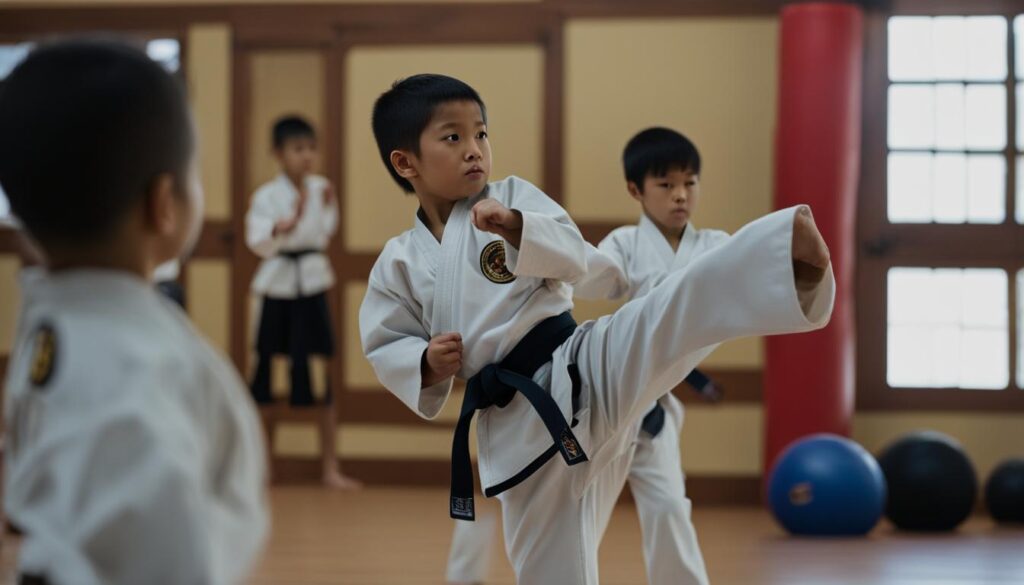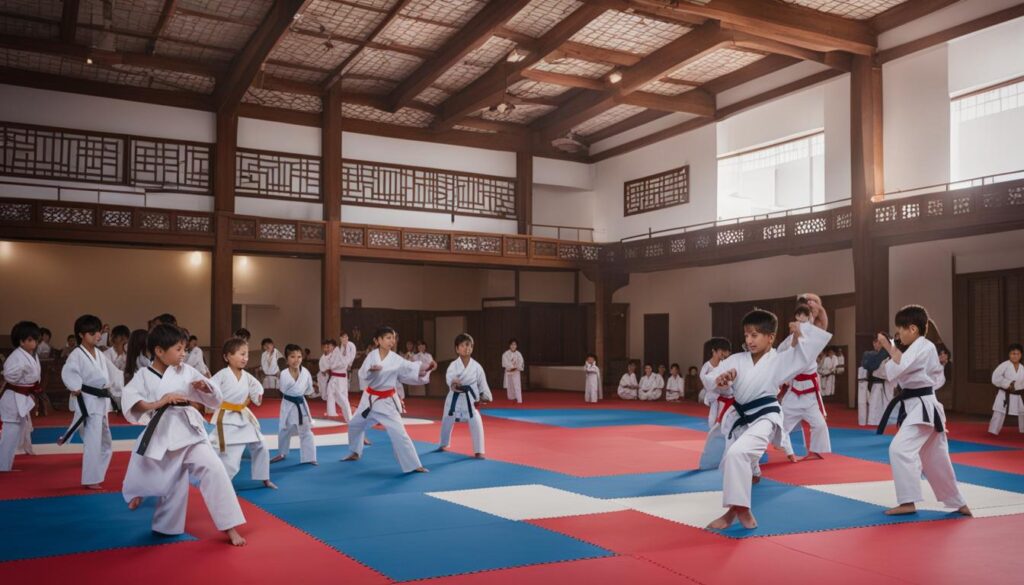Choosing the right martial art for your child can be a difficult decision. With so many options available, it’s important to consider the specific benefits and qualities of each discipline. In this article, we will explore the differences between karate and taekwondo and help you determine which martial art is better suited for your child’s needs.
Key Takeaways:
- Both karate and taekwondo offer unique benefits for physical and mental development in children.
- Karate focuses on striking techniques and close-in defense, while taekwondo emphasizes kicks and keeping opponents at a distance.
- The ideal age to start martial arts training varies for each child, but it is generally recommended to wait until a child is at least 3 years old and shows signs of mental readiness.
- When choosing a martial arts school, consider the school’s philosophy, teaching style, and the presence of a child development program.
- Karate training often involves forms or katas, while taekwondo training focuses on poomse and high-intensity kicks.
The Difference Between Karate and Taekwondo
Karate and taekwondo are two popular martial arts forms that offer unique approaches to self-defense, physical fitness, and coordination. While both martial arts can be child-friendly and provide effective self-defense training, they have distinct characteristics that set them apart.
When comparing karate and taekwondo, it’s important to understand their primary focuses. Karate primarily emphasizes striking techniques and close-in defense, teaching practitioners to defend themselves in close quarters and use their hands and feet effectively. On the other hand, taekwondo places a strong emphasis on high-intensity kicks and maintaining distance from the opponent, combining powerful kicks and agile footwork for self-defense and sparring.
Both martial arts offer child-friendly environments that promote discipline, respect, and focus.
Moreover, karate and taekwondo provide valuable physical fitness benefits for children. Through precise techniques and repetitive movements, karate helps develop strength, coordination, and balance. Taekwondo’s focus on kicks and dynamic movements promotes flexibility, agility, and cardiovascular endurance. Both martial arts contribute to the overall well-being of children, enhancing their physical capabilities and promoting an active lifestyle.
Additionally, karate and taekwondo equip children with self-defense skills that can boost their confidence and provide a sense of security.
To summarize:
| Karate | Taekwondo |
|---|---|
| Focuses on striking techniques and close-in defense | Emphasizes high-intensity kicks and maintaining distance |
| Develops strength, coordination, and balance | Promotes flexibility, agility, and cardiovascular endurance |
| Provides effective self-defense training | Enhances self-defense skills and confidence |
Ultimately, the choice between karate and taekwondo for your child depends on their personal interests, preferences, and goals. It’s important to consider their individual characteristics and match them with the martial art that aligns best with their needs. Consulting with instructors and visiting local martial arts schools can provide valuable insights to help you make an informed decision for your child’s martial arts journey.
Age and Readiness for Martial Arts
The ideal age to start martial arts training varies for each child. Generally, it is recommended to wait until a child is at least 3 years old and shows signs of mental readiness. However, each child is different, and it’s important to consider their individual development and maturity before enrolling them in martial arts classes.
Martial arts can provide numerous benefits, such as improved physical fitness, discipline, confidence, and self-defense skills. However, young children may not fully grasp the concepts and techniques taught in martial arts classes. It’s crucial to ensure that they have the cognitive skills and emotional maturity to understand and follow instructions.
Mental readiness for martial arts involves several factors, including:
- Attention span and focus: Children should be able to concentrate for short periods of time and follow directions.
- Emotional stability: They should have a basic understanding of emotions and be able to regulate their behavior.
- Motivation and interest: Children who express an interest in martial arts are more likely to stay engaged and committed to their training.
By starting martial arts when a child is mentally ready, they can better absorb the teachings, enjoy the classes, and progress at their own pace. It’s essential to consult with instructors or martial arts professionals who can assess your child’s readiness and recommend an appropriate starting age.

Choosing the Right Martial Arts School
When it comes to enrolling your child in a martial arts program, selecting the right school is crucial. The philosophy and teaching style of the martial arts school can significantly impact your child’s experience and development. It’s essential to choose a school that aligns with your family’s goals and values, ensuring a positive and enriching martial arts journey for your child.
A child-friendly martial arts school should prioritize discipline, respect, and focus while also providing a fun and inclusive learning environment. These values lay the foundation for your child’s character development and help them build important life skills such as self-discipline, confidence, and perseverance. Look for a school that emphasizes these principles and incorporates them into their training curriculum.
In addition to the school’s philosophy, consider the presence of a child development program. Such programs can offer tailored activities and exercises that promote physical, cognitive, and social development in children. These programs go beyond martial arts training and provide comprehensive support for your child’s growth and success.
Choosing the right martial arts school is about more than just learning self-defense techniques. It’s an opportunity for your child to learn valuable life lessons, develop important skills, and grow into a confident and disciplined individual.
Differences in Training and Techniques
When it comes to training methods and techniques, karate and taekwondo offer unique approaches that cater to different aspects of physical and mental development in children. Understanding these differences can help parents make an informed decision when choosing between the two martial arts.
Karate Training:
Karate training places a strong emphasis on forms, also known as katas. These are choreographed movements that help students develop proper technique, precision, and muscle memory. By repeatedly practicing these forms, children enhance their overall physical coordination and control. Karate training also incorporates various striking techniques, such as punches, kicks, and blocks, which improve strength, flexibility, and speed.
Taekwondo Training:
On the other hand, taekwondo training is characterized by patterns called poomse, which involve a series of fluid and dynamic movements. These patterns focus on flexibility, balance, and high-intensity kicks. Taekwondo also emphasizes the use of legs as powerful weapons for both defense and offense. By training in taekwondo, children improve their agility, leg strength, and control in executing precise kicks.
Both karate and taekwondo provide physical and mental development through discipline, focus, and perseverance. While karate highlights a balance between striking and defense techniques, taekwondo emphasizes kicks and maintaining distance from opponents. The training methods are designed to instill discipline, concentration, and self-control in children, promoting a healthy mind-body connection.
Below is a visual representation of the differences in training and techniques:
| Karate Training | Taekwondo Training |
|---|---|
| Forms (Katas) | Poomse Patterns |
| Striking Techniques | High-Intensity Kicks |
| Focus on close-in defense | Emphasis on maintaining distance |
| Improves overall physical coordination and control | Enhances agility and leg strength |

By understanding the differences in training and techniques, parents can choose the martial art that aligns with their child’s interests, goals, and learning style. Whether it’s karate or taekwondo, both martial arts offer valuable opportunities for children to develop physical skills, cultivate discipline, and build confidence.
Conclusion
Deciding between karate and taekwondo for your child depends on their individual interests, preferences, and goals. Both martial arts offer valuable life skills and physical fitness benefits, making them excellent choices for children.
When choosing the right martial art for your child, it’s crucial to consider their specific needs and personality. Some children may prefer the striking techniques and close-in defense of karate, while others may be drawn to the high-intensity kicks and flexibility emphasized in taekwondo.
To make an informed decision, consult with instructors from different martial arts schools. By visiting various schools, you can get a firsthand sense of their teaching philosophy and determine which one aligns best with your family’s goals and values.
Whether your child ultimately chooses karate or taekwondo, both martial arts foster discipline, focus, and perseverance. These skills will not only benefit them on the mat but also in other areas of life.
FAQ
What are the benefits of karate and taekwondo for kids?
Both karate and taekwondo offer physical and mental development for children. They provide effective self-defense training, improve overall fitness and coordination, and teach discipline, respect, focus, and perseverance.
What is the difference between karate and taekwondo?
Karate focuses on striking techniques and close-in defense, while taekwondo emphasizes kicks and keeping opponents at a distance. Both martial arts offer child-friendly training and are suitable for self-defense.
When is the ideal age to start martial arts training?
It is generally recommended to wait until a child is at least 3 years old and shows signs of mental readiness. However, each child is different, and their individual development and maturity should be taken into consideration.
How do I choose the right martial arts school for my child?
When choosing a martial arts school, consider its philosophy and teaching style. Look for a school that aligns with your family’s values and prioritizes discipline, respect, focus, and a fun and inclusive learning environment. A child development program can further enhance your child’s growth and success.
What are the differences in training and techniques between karate and taekwondo?
Karate training often involves forms or katas, which are choreographed movements that develop proper technique and muscle memory. Taekwondo training focuses on patterns called poomse and emphasizes flexibility and high-intensity kicks.
Which martial art should I choose for my child?
The choice between karate and taekwondo depends on your child’s individual interests, preferences, and goals. Both martial arts offer valuable life skills and physical fitness benefits. Consider your child’s specific needs and personality to make an informed decision.
Source Links
- https://focusmartialarts.com.au/karate-classes/kids-karate-lessons-vs-taekwondo-classes-how-to-choose-which-one-would-be-best-for-my-child/
- https://www.chicagoschoolofgrappling.com/post/top-5-reasons-why-karate-tae-kwon-do-aren-t-good-for-your-kid
- https://www.sportsrec.com/7550755/karate-vs-taekwondo-for-kids
